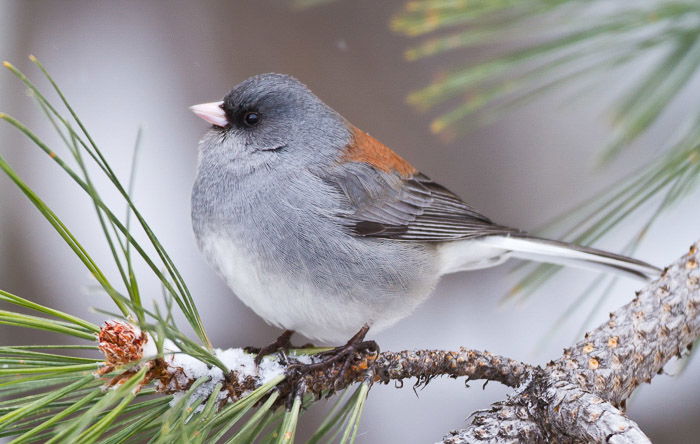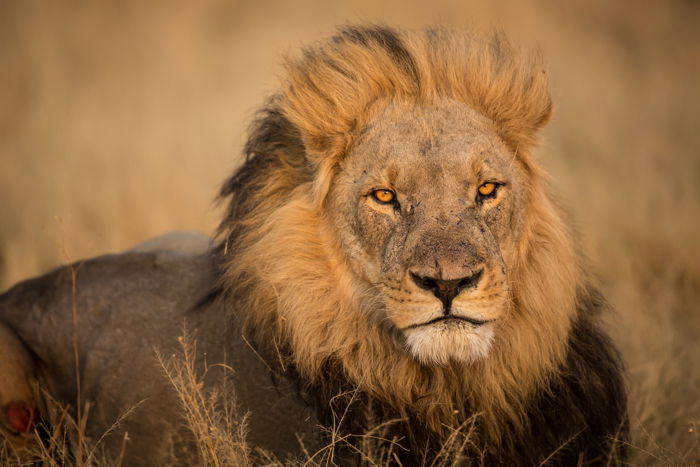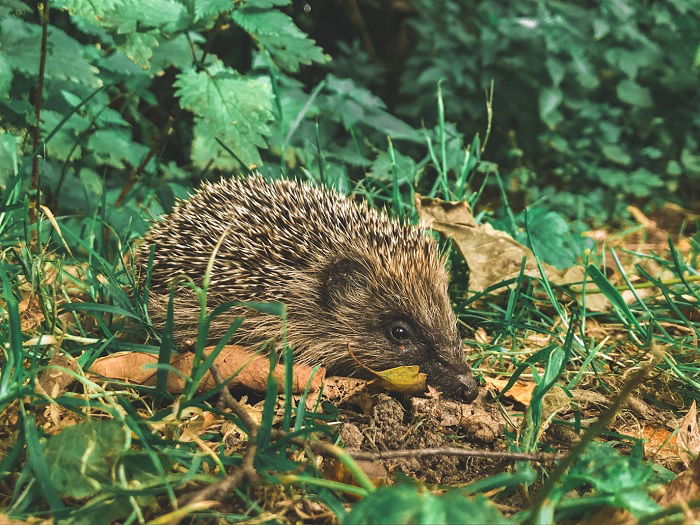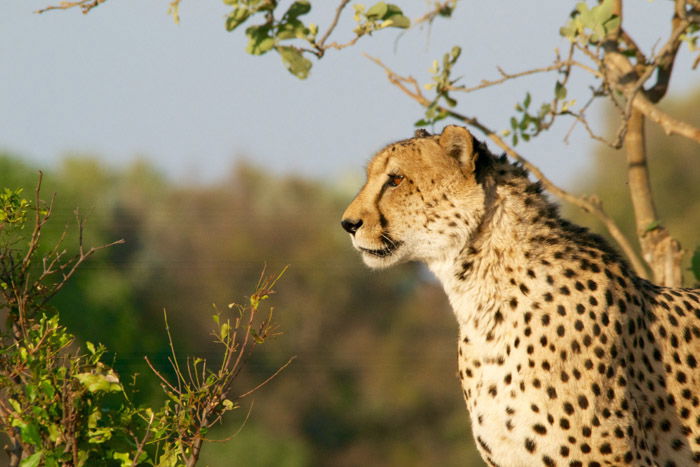How to Shoot Eagle Photography (Locations, Settings & Tips)
Eagle photography can be a thrilling experience, but it takes some skill to get great shots of these majestic birds. Here are a few tips to help you capture the perfect photo of an eagle in flight.
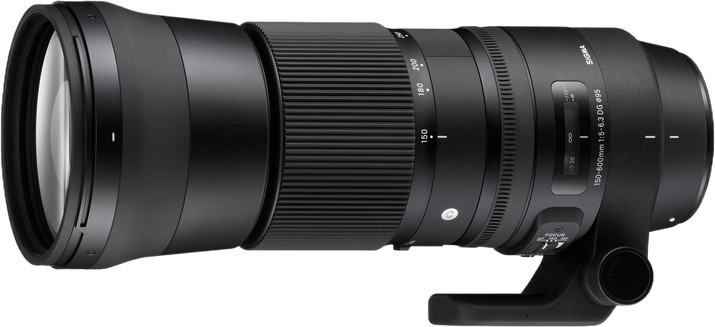
Eagle Photography: How Do You Capture These Majestic Birds?
There is something special about eagles. Maybe it's their size and strength, the intensity of their stare, or their ferocity. Whatever it is, eagles are compelling photo subjects.
To get a good eagle photo, you need to do more than visit the right location. You need to understand eagle behaviour. You also need to face the challenges of metering and exposure, wildlife composition, and birds in flight photography.
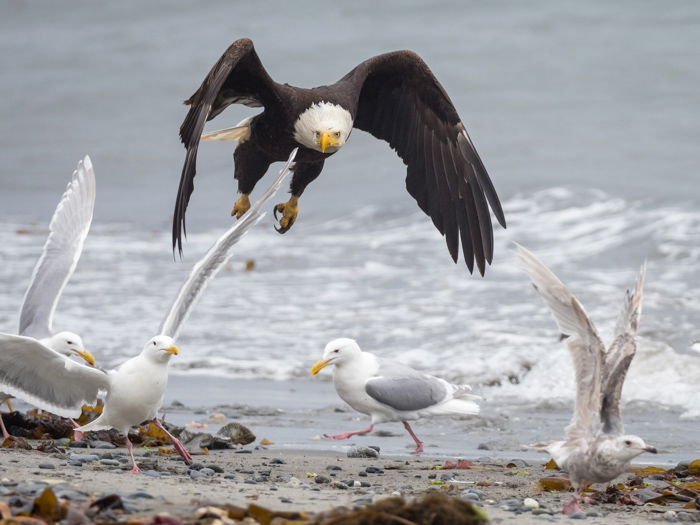
Eagle Photography Ethics
Before photographing any wildlife, always ask yourself if your actions are causing harm. If the answer is yes, don't do it. Be honest with yourself. Your photos are not as important as the animal's well-being.
Many species of eagles are at risk. Habitat loss, lead poisoning, poaching, and climate change are all taking a toll on eagles. As photographers, we need to be aware of these threats and take every precaution not to add to the problem.
The repeated stress caused by too-close photographers and wildlife viewers can impact wildlife. Eagles are no exception. Be cautious around the birds. If you need to approach them, do so slowly, and step back if the eagle starts to get agitated.
Never approach a nest.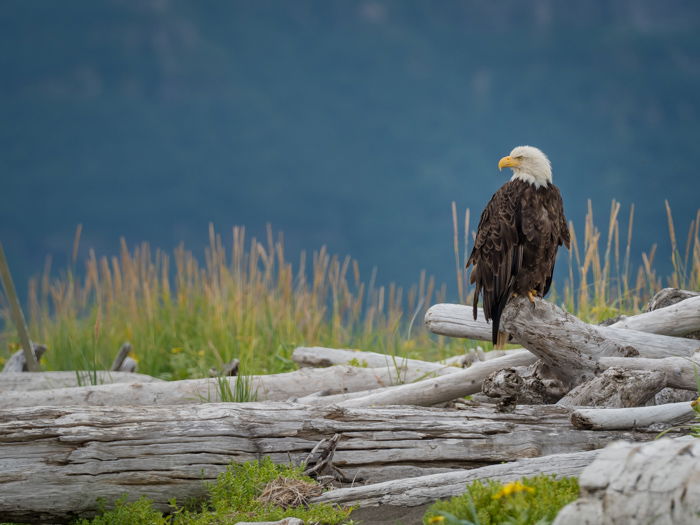
A Note on Baiting
Baiting is unethical, can lead to harmful behavioural changes, and is often illegal. Aside from satisfying your own urge to create an image, baiting eagles does nothing good. In areas where baiting of eagles occurs, the birds have lost their fear of people and can approach dangerously close. Providing food can make young birds dependent on humans and impede their natural hunting instincts.
Just don't do it. And don't support unethical tour operators who participate in baiting.
Research to Get the Best Eagle Images
To get the best images of eagles (or any other subject), you need to know something about them. Whether it’s Bateleur Eagles in the Okavango Delta or Bald Eagles in Alaska, you need to know about behaviour and natural history.
An example: In Alaska, just at the breeding season is wrapping up, our resident Bald Eagles are exhausted. And they look it. Their feathers are old, they've been spending a lot of time on muddy beaches, and frankly, they look a bit tattered.
Of course, this can be a great time of year to get interesting behaviour photos. Post-breeding adults are feeding and interacting with their young and with one another. But for portraiture, they aren't looking their best.
If you want to get the perfect, clean portrait of a Bald Eagle, you're better off coming in the winter.
You also need to know the big things. If the species is migratory, you need to plan your expedition when the birds are around!
You can see what I'm getting at: you need to know your subject.
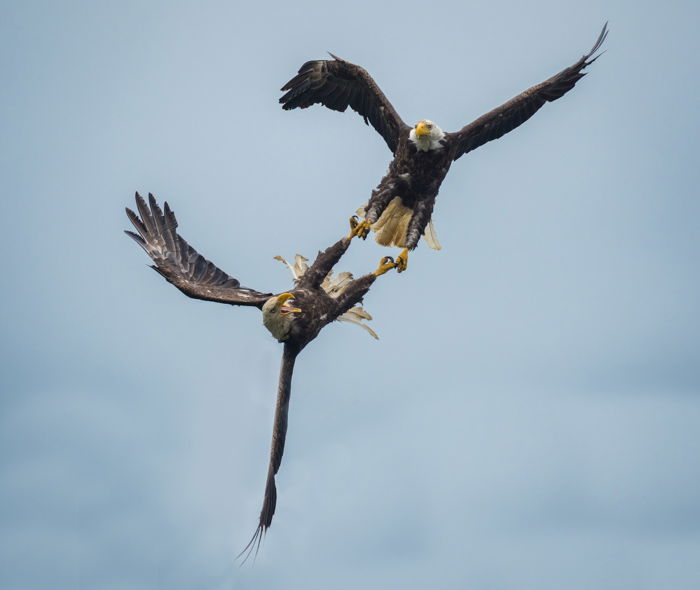
These mid-summer eagles are looking a bit tattered, but the action makes up for a lot.
Choosing the Best Focal Length for Eagle Photography
Eagle photography is not much different than any other form of wildlife photography. A long lens, between 400 and 600mm is preferable. But, having options is important. You may wish to have a second camera mounted with something wider. A 70-200 or 100-400 lens are good secondary options. In some places, eagles can be photographed close up, and a wider lens may be better than a long telephoto.
When photographing wildlife, I always have a long prime telephoto on one camera and a wider zoom on a second. This allows me to quickly switch between them without having to think about it.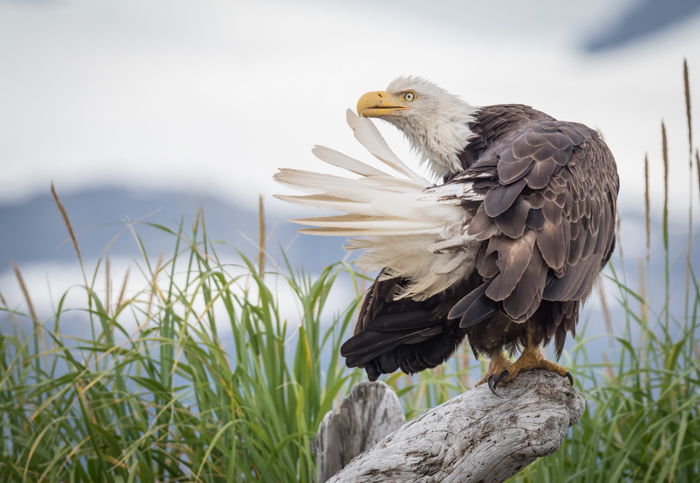
How to Get the Exposure Right
Adult Bald Eagles have dark brown bodies and bright white heads and tails. Probably the most common mistake photographers make, is exposing for the bird's body. When your camera thinks the dark brown feathers are properly exposed, you'll likely blow out the white.
The trick is to underexpose the bird's body by about a stop (or even more in bright sunlight). Use your LCD to zoom in and confirm your exposure. Use your camera's "blinkies" to show overexposed highlights. Your image, in-camera, may look too dark, but retaining the detail in the bird's head is key to a successful image.
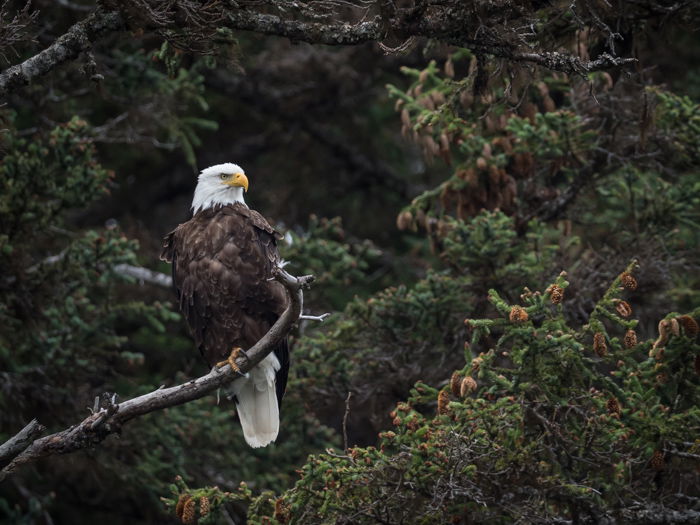
If I’d exposed my image here based on the dark background here, I would have lost the details on the bird’s head. This way, the image is dark overall, but the bright white head of the eagle stands out nicely and retains all the detail.
Metering
Spot metering may help improve your exposure. I use spot metering most of the time for wildlife. In this discipline, most images have a clear and dominant subject (the animal). That subject needs to be properly exposed. With Bald Eagles, spot metering the head can be the most effective way to determine the exposure.
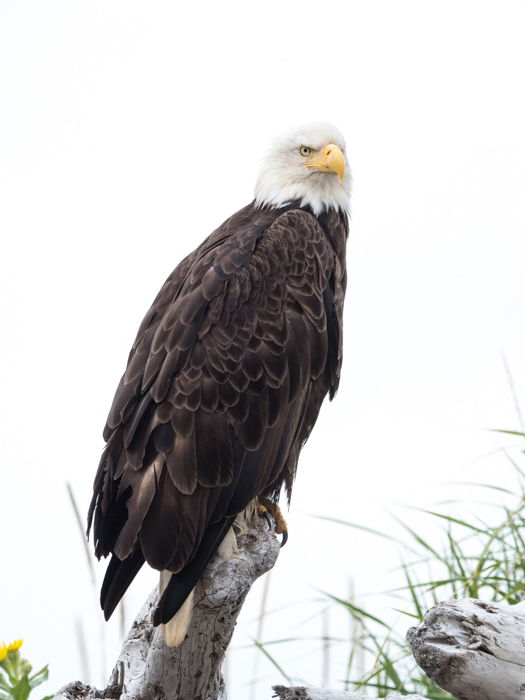
It was a bright, overcast day when I made this image. There was nothing in the background that I cared about, so I went for a high-key shot, blowing out the background to white while returning all the detail in the bird. A good compromise.
Capturing Eagles in Flight
Few things to compare to the drama of an enormous eagle sweeping past. Even a scruffy-looking, mid-summer eagle can look great in flight. Fortunately, eagles are easier than many species to photograph in flight. They are large and fly at a moderate pace. But there are a few things you can do to optimize your odds of success.
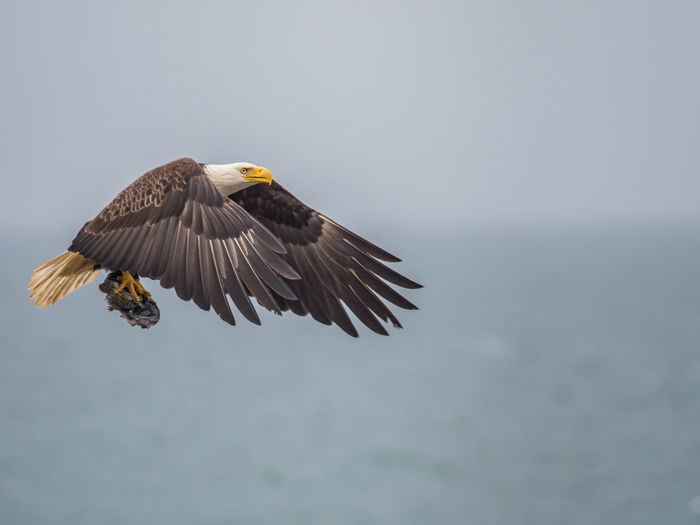
Use a Fast Shutter Speed
Assuming you aren't striving for a motion blur, you need a fast shutter speed for a sharp image. At least 1/1250th of a second is needed to assure sharpness, and even more, can be better.
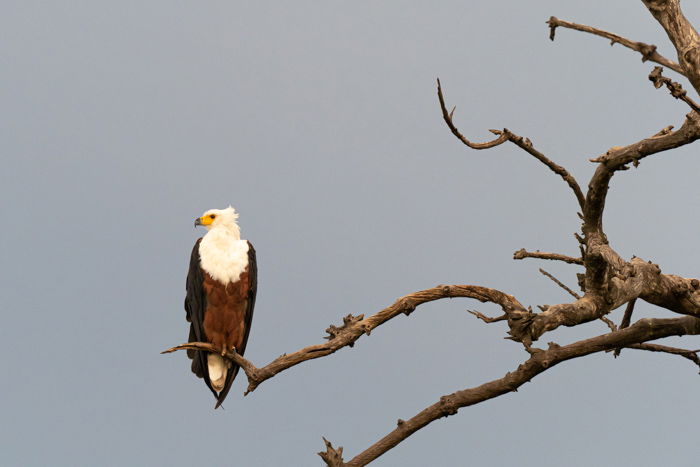
When I made this image of an African Fish Eagle in Botswana, I was bobbing around in a boat on the Chobe River. Even though the bird wasn’t moving, I was, so a fast shutter speed was required.
To attain that fast shutter, open up your aperture, and use a high ISO. In bright conditions, an ISO of 800 might be enough. On cloudy days, or early or late, you might need to push that higher. While high ISOs will cause noise, it's better to get a sharp, but slightly noisy photo, than a blurry but noiseless one.
Focus on the Eye of the Eagle
The goal is to get the bird's eye in focus. Set your camera to continuous or follow-focus and use a small cluster of autofocus points. Single point focus makes it too easy to slip away from the subject while you pan your camera. While a large grouping means the camera may select a wing-tip or shoulder instead of the face.
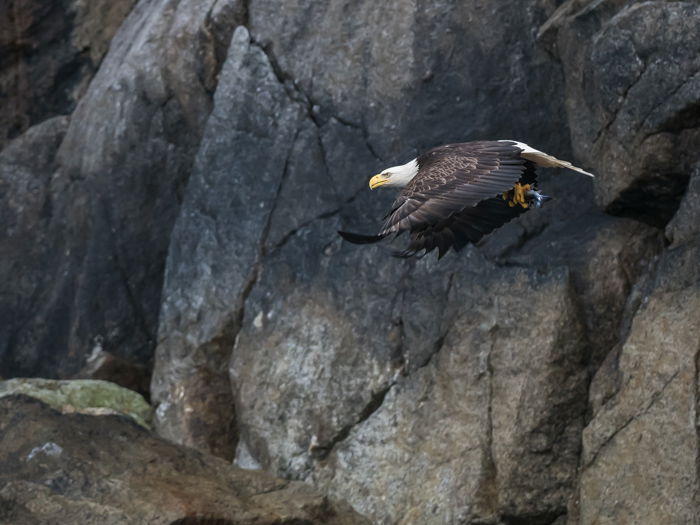
Don’t Forget the Composition
My first trip to Africa, I saw a Martial Eagle, one of the world’s largest and most powerful species. It was a quick sighting. The bird ew over the safari vehicle. The light was harsh, bright, and the fly-over too fast for me to go for a camera. But the size and inherent strength of that bird stuck with me. I knew I wanted to get back to Botswana to photograph it.
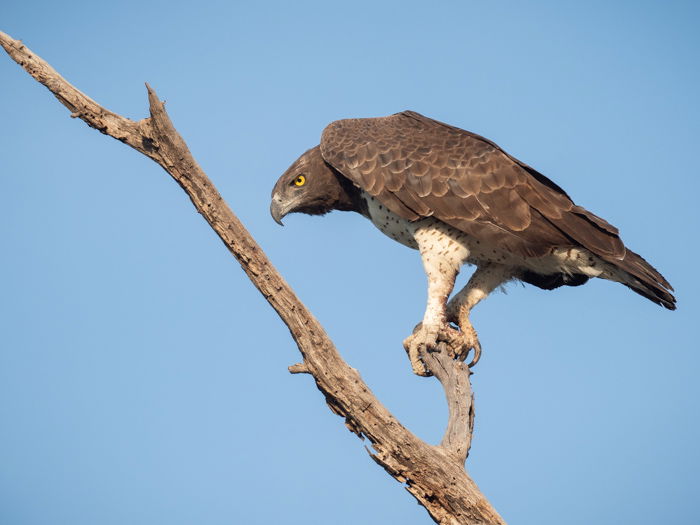
The plain blue background and profile perspective in this shot were fine but hardly dynamic.
Two years later, I got that opportunity. I was leading a photo trip, and one of our local safari guides spotted a Martial Eagle atop a tree. Raptors like to sit up high, where they can more easily spot prey. Unfortunately, my position far below was not a great place to photograph it. The bird was in profile, staring to our left.
It took a quick shift of position to completely change the image. We moved into the eagle’s gaze. Suddenly the huge predator was staring right down the barrel of my lens, and I had the image I wanted.
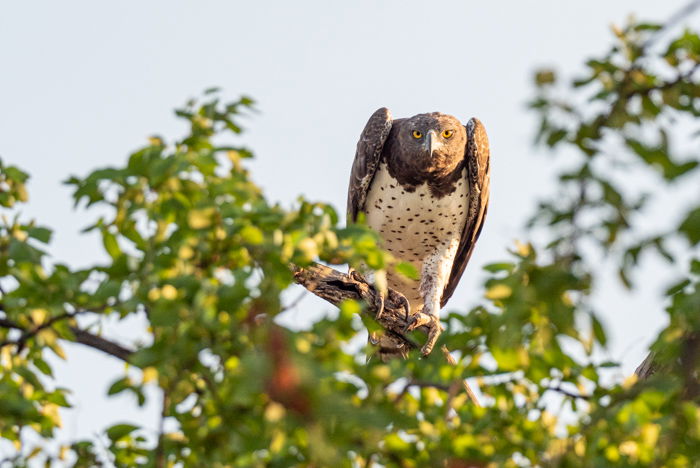
This image of the same Martial Eagle bird, however, is much more compelling. Eye contact, a more interesting perch and a better sense of the location provided by the fresh green leaves.
Composition in eagle photography is as important as in any other discipline. Not every shot needs to be a tight portrait. A perched bird may give you the opportunity to create many shots. Don't make them all the same. As I did with the Martial Eagle noted above, if you can move around without disturbing your subject, do so! Experiment with different focal lengths and composition. There is no point in purring off hundreds of shots of the same thing. Make something new.
As a professional who sells and publishes many photos, I've found it's rarely the tight shot that sells. In wildlife photography, there are thousands of tight portraits out there. To buyers, this gets boring. Tight portraits don't offer room for text, logos, or other design elements. So don't be afraid to leave some negative space, or feel like you have to get too close.
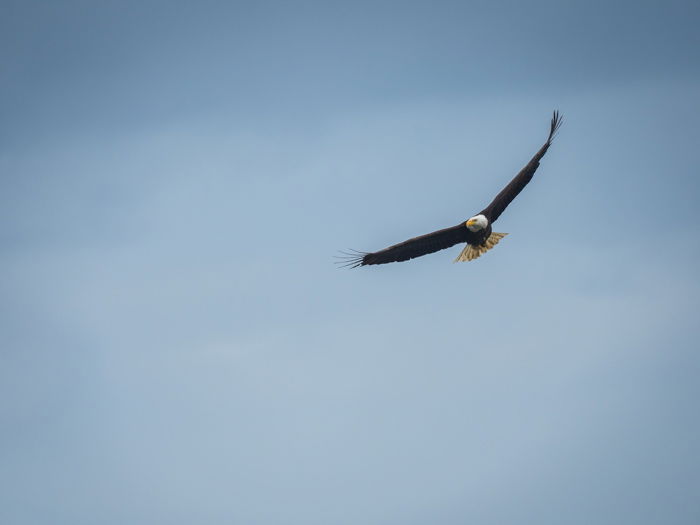
This is one of my best-selling photographs of a bald eagle. There is lots of space for text and other design elements, making it appealing to buyers.
Flight Composition
In eagle flight photography, many of the same guidelines apply. But one general rule is worth noting: leave somewhere for the bird to go. Shift your composition so there is some negative space in front of the flying bird. That way, it won't look like the eagle is about to fly from the frame.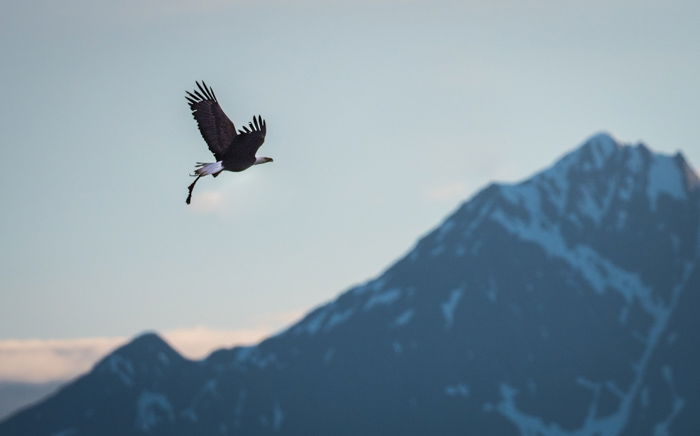
Where Can I Take Eagle Pictures?
As I noted toward the beginning of this article, most of us live within the range of at least one species. If you live in Africa, you've got dozens that can occur nearby. Finding them can be a challenge. Do your research. Learn about your local species, its preferred habitats, migration strategies, and behaviour. Armed with that information, you'll have better success finding that photo.
Here in North America, we only have two species of Eagles, but one of them is the charismatic Bald Eagle. Fortunately for us, Bald Eagles tend to occur in certain locations. The largest congregation of Bald Eagles in the world happens along Alaska’s Chilkat River in November. But that's not the only location the birds come together. In the eastern United States, many eagles occur at Maryland's Conowingo Dam. There, you can see and photograph them fishing below the dam and perched in riverside trees.
The Pacific Northwest of the United States and western Canada has abundant Bald Eagles during both summer and winter. Even the Great Plains have many nesting eagles along rivers and lakes where fish are abundant.
Look to your local birding and conservation groups for information about eagles. If you show yourself to be responsible, they will likely be happy to point you in the right direction.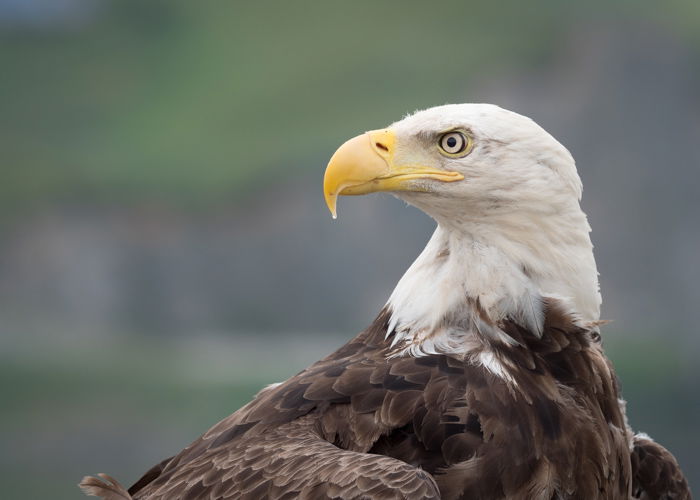
Conclusion
Photographing eagles can be one of the most enjoyable photographic pursuits. They are charismatic, big, and frequently occur in beautiful places.
To get the best shots possible, you need to put location, timing, and camera skill together. Before you head out, practice getting exposures right, get your focus strategy nailed down, and don't forget the composition. If you come to Alaska to make images of Bald Eagles, look me up! I'll get you pointed in the right direction.
Check out our Simply Stunning Landscapes course next!

